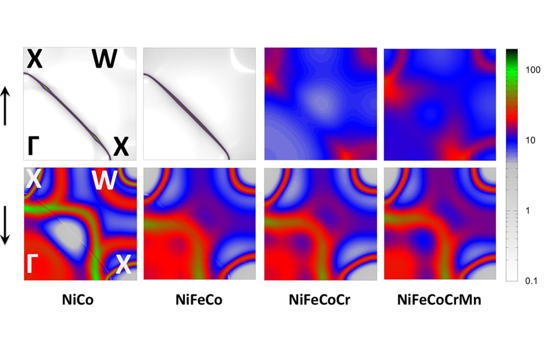 Uncovering electron scattering mechanisms in NiFeCoCrMn derived concentrated solid solution and high entropy alloys (揭示NiFeCoCrMn衍生浓缩固溶体和高熵合金中的电子散射机制)
Uncovering electron scattering mechanisms in NiFeCoCrMn derived concentrated solid solution and high entropy alloys (揭示NiFeCoCrMn衍生浓缩固溶体和高熵合金中的电子散射机制)
Sai Mu, German D. Samolyuk, Sebastian Wimmer, Maria C. Troparevsky, Suffian N. Khan, Sergiy Mankovsky, Hubert Ebert & George M. Stocks
npj Computational Materials 5:1 (2019)
doi:s41524-018-0138-z
Published online:04 January 2019
Abstract| Full Text | PDF OPEN
摘要:虽然人们早就知道位错严重影响输运性能,但最近对一系列固溶体3d-过渡金属合金的测量结果显示,残余电阻率有两个数量级的差异。使用从头算方法,我们证明,虽然所有合金的载流子密度都与普通金属一样高,但电子平均自由程可以从~10 A(强散射极限)到~103 A(弱散射极限)变化。本研究描绘了导致这种不同行为的潜在电子散射机制。虽然位点对角线、自旋、潜在散射总是占据主导地位,但对于仅含Fe、Co和Ni的合金,多数自旋通道经历的无序散射可以忽略,从而提供了短路,而对于含Cr或 Mn的合金,两者都具有自旋通道,由于电子填充效应而经历了强无序散射。有些令人惊讶的是,其他一些散射机制——包括位移效应或尺寸效应,散射已被证明与诸如屈服强度之类的各种性质有强相关性——现在却被发现在大多数情况下都是相对较弱的相关性。
Abstract:Whilst it has long been known that disorder profoundly affects transport properties, recent measurements on a series of solid solution 3d-transition metal alloys reveal two orders of magnitude variations in the residual resistivity. Using ab initio methods, we demonstrate that, while the carrier density of all alloys is as high as in normal metals, the electron mean-free-path can vary from ~10A (strong scattering limit) to ~103A (weak scattering limit). Here, we delineate the underlying electron scattering mechanisms responsible for this disparate behavior. While site-diagonal, spin dependent, potential scattering is always dominant, for alloys containing only Fe, Co, and Ni the majority-spin channel experiences negligible disorder scattering, thereby providing a short circuit, while for Cr/Mn containing alloys both spin channels experience strong disorder scattering due to an electron filling effect. Somewhat surprisingly, other scattering mechanisms—including displacement, or size effect, scattering which has been shown to strongly correlate with such diverse properties as yield strength—are found to be relatively weak in most cases.
Editorial Summary
Disordered alloys: Resistivity by smearing (无序合金:通过涂抹的电阻率)
该研究用高熵合金中特定合金元素引起的费米表面涂抹,解释了不同电阻率的测量。由美国橡树岭国家实验室的George Malcom Stocks领导的团队,使用从头算方法研究了Cantor-Wu族面心立方无序合金残余电阻率差异背后的电子散射机制。模拟首先再现了实验观察到的结果,即含有锰和铬的合金具有高的残余电阻率,而所有其他Cantor-Wu合金都只有低的残余电阻率。单位点电子散射,结合磁性引起的散射,说明这一现象是由于锰和铬引起费米表面因半填充的d带而导致的涂抹。深入理解无序合金中的电子传输,将有助于阐明它们更有特色的性质。
Smearing of Fermi surfaces caused by specific alloying elements in high-entropy alloys explains disparate resistivity measurements. A team led by George Malcom Stocks at Oak Ridge National Laboratories in Tennessee, USA, used ab initio methods to investigate electron scattering mechanisms behind differences in residual resistivity of the Cantor-Wu family of face-centered cubic disordered alloys. The simulations first reproduced the experimental observation that alloys containing manganese and chromium had high residual resistivities, while all other Cantor-Wu alloys had low residual resistivities. Single-site electron scattering, in combination with scattering caused by magnetism, showed that this was due to manganese and chromium causing smearing of the Fermi surfaces due to their half-filled d-bands. Better understanding of electronic transport in disordered alloys may help elucidate their more exotic properties.


 沪公网安备 31010502006565号
沪公网安备 31010502006565号